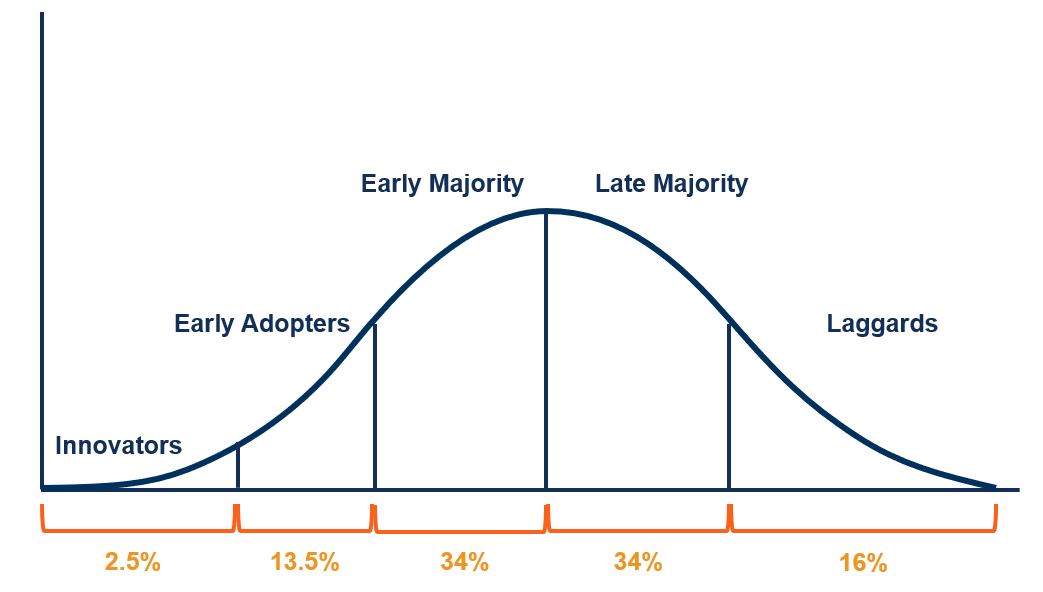Safety is paramount in every organisation. Irrespective of the industry, ensuring that all stakeholders remain shielded from harm is a critical component of operational success. However, as businesses evolve and the external environment shifts, the safety protocols and practices we’ve grown accustomed to may need to be revised or replaced. But how do you effectuate change in an organisation where the tried-and-tested is the norm? Enter the Diffusion of Innovation theory.
Understanding the Diffusion of Innovation (DOI) theory isn’t just for tech start-ups or marketing professionals—it’s a potent tool for anyone aiming to bring about organizational change. Originally conceptualized by sociologist Everett Rogers in 1962, the theory delineates how new ideas, behaviours, and products take root in societies and organisations. By harnessing its insights, safety leaders can strategically guide their organisations toward safer horizons. Here’s how:
1. Recognize the Adopter Categories
In every organisation, employees can be categorized into groups based on their willingness to embrace new ideas:
- Innovators: Always eager to try something new. They’ll be your initial testers.
- Early Adopters: Key opinion leaders. Once convinced, they can become your change ambassadors.
- Early Majority: They observe and ponder before embracing change, but their acceptance is pivotal to the change becoming the new norm.
- Late Majority: They’re usually sceptical, adopting new safety practices only when they see most of their colleagues doing so.
- Laggards: Resistance to change characterises this group. They cling to traditional methods and need additional persuasion.
By identifying and understanding these groups, safety leaders can tailor their approach, ensuring smoother transition and adoption.
2. Highlight the Relative Advantage
To encourage uptake of new safety practices, emphasise their benefits over current methods. Whether it’s a new fire safety protocol that’s 50% more effective or a workplace ergonomic solution that decreases injury rates by 30%, such comparative advantages must be highlighted and communicated consistently.
3. Ensure Compatibility with Current Practices
It’s essential that new safety practices align with existing organisational values and processes. If a proposed change is perceived as too radical or misaligned with current beliefs, its acceptance becomes challenging. Prioritise changes that are a natural evolution of existing practices or, if a radical shift is needed, invest time in aligning organisational values first.
4. Simplify the Complex
Any new process can seem daunting initially. However, by breaking down new safety practices into digestible steps, providing training, and offering easy-to-follow guidelines, the perceived complexity can be reduced, making adoption more likely.
5. Offer Trialability
Allowing teams to test and experiment with new safety protocols in a controlled environment can alleviate apprehensions. If a new safety equipment or protocol is introduced, perhaps a pilot phase in one department can help iron out kinks and offer proof of concept.
6. Show, Don’t Just Tell
Observability is pivotal. When employees see tangible results from new safety practices—be it in the form of reduced incident rates, improved safety scores, or positive testimonials from colleagues—they’re more likely to adopt these practices themselves.
7. Engage Change Agents and Opinion Leaders
Every organisation has influential figures whose opinions are valued. Engaging with these change agents and getting them on board can lead to a cascade effect, with their endorsement influencing a wider circle of employees.
8. Address Consequences Proactively
While the primary focus is on the positive impact of new safety practices, it’s also vital to address any potential drawbacks transparently. This approach not only builds trust but allows the organisation to develop mitigation strategies in advance.
Conclusion
Change, especially when it concerns safety, is non-negotiable. However, the pathway to change doesn’t have to be fraught with obstacles. By leveraging the insights from the Diffusion of Innovation theory, organisations can strategically, authoritatively, and positively usher in new safety practices, ensuring a safer, more secure working environment for all. Embrace change with knowledge and strategy, and watch your organization transform into a beacon of safety excellence.
If you would like to know more or would like our assistance in the areas mentioned check us out at www.intrinsicsafety.com.au. Alternately, call us on 1300 990 336 or email us at in**@*****************om.au


